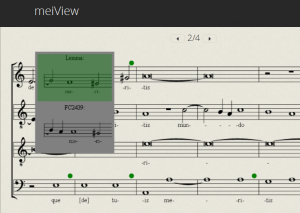


Historical musical pieces make their way to us through multiple documents and it often happens that multiple sources introduce differences and variants in the music. meiView is a sample web application capable of displaying 15–16th century music (more precisely, the transcription of such music into common western music notation), and provide a dynamic mechanism for the user to select which variant they want to see.
For a demonstration of its capabilities, open meiView, and click on the green dots to see the differences between the sources. In the sidebar you can see the highlighted sources and variants you have selected. When you select a variant, the score automatically updates so that the selected variant is displayed. With this application you can select an arbitrary combination of variants, effectively creating your own ‘edition’ or a customized ‘view’ of the music.
MEI View uses MEItoVexFlow, a JavaScript library which converts MEI-encoded music notation into drawing instructions for the open-source VexFlow online music notation rendering API. This library was first created by Richard Lewis, then expanded as part of The Lost Voices Project. Most recently MEItoVexFlow has been improved on by Zoltán Kőmíves thanks to sponsorship from Google Summer of Code awarded to the Maryland Institute for Technology in the Humanities (MITH). It has been further enhanced thanks to funds from Haverford College and a Scholar Editions Grant from the NEH.